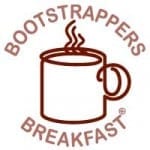New startups form in private conversations: here are some ways to make it easy for potential cofounders to find you based on the problem you are working on or customer need you plan to address.
New Startups Form in Private Conversations


Mike introduced me as the founder of the Bootstrapper Breakfasts and I gave my “we help teams of two to five engineers or scientists generate leads and close deals” intro. But I realized, after the Zoom session was over, that it was 30 minutes shorter than a regular breakfast because it was missing the key networking time after the breakfast that is hard to support in current on-line tools. I have the same challenge in the Silicon Valley Bootstrapper Breakfasts that I facilitate.
Side Conversations Enable Founders to Get Acquainted
 A Bootstrapper Breakfast® begins by going around the table and asking everyone to give short introduction about themselves and what they are working on. We invite them to put an issue or challenge or decision they are wrestling with on the table for the group to help clarify and offer perspectives. The facilitator writes down the issues and makes sure they get put on the table before the meeting breaks up, sometimes combining them where appropriate with similar questions from other attendees. It gives entrepreneurs a chance to compare notes and get a sense of how others around the table diagnose, explore, and solve problems.
A Bootstrapper Breakfast® begins by going around the table and asking everyone to give short introduction about themselves and what they are working on. We invite them to put an issue or challenge or decision they are wrestling with on the table for the group to help clarify and offer perspectives. The facilitator writes down the issues and makes sure they get put on the table before the meeting breaks up, sometimes combining them where appropriate with similar questions from other attendees. It gives entrepreneurs a chance to compare notes and get a sense of how others around the table diagnose, explore, and solve problems.
In the traditional (pre-COVID-19) format of the Bootstrapper Breakfasts, we asked that attendees “please have one conversation around the table” during the formal event. But there were always folks who arrived early and many who stayed afterwards, leading to many valuable side conversations during the preamble and especially after the formal end of the meeting. And it’s in these conversations that people begin to get acquainted more fully and form teams.
We Need to Make Private Conversations Easier


I will often follow up with one or two attendees after a breakfast and suggest they speak with an entrepreneur who was not at the breakfast they attended. Sometimes this is because they have a skill that the attendee may have a short term need for. Sometimes they may have information or a perspective that might help. Sometimes the two people I introduce are working on different aspects of the same problem and should consider joining forces, if only temporarily. Sometimes I think they have shared values and complementary skills and might make good cofounders. I do this via email and encourage them to schedule a phone call or take a coffee break. But the pandemic has taken the coffee break option off the table. And the economic fallout from the pandemic may kill a lot of low-cost restaurants and coffee shops–and coworking spaces–where casual business conversations could take place.
We encourage attendees to add their thoughts and suggestions in shared Google Doc we use for group notes. We share everyone’s email addresses when we mail out a copy of the shared notes to all attendees. We leave the chat access open as well, which provides another channel for connection that complements voice and shared notes. From time to time, we invite a briefing on a special topic by a featured attendee; this attracts entrepreneurs who are interested in the highlighted emerging problem/opportunity area.
We will continue to adapt and refine our approach, as entrepreneurs always do. But this time of shelter in place has brought home the value of face to face conversations for new startup formation, and the events and business locations that can facilitate them.
What You Can Do as an Entrepreneur
“I noticed the following facts about people who work with the door open or the door closed. I notice that if you have the door to your office closed, you get more work done today and tomorrow, and you are more productive than most. But 10 years later somehow you don’t know quite know what problems are worth working on; all the hard work you do is sort of tangential in importance. He who works with the door open gets all kinds of interruptions, but he also occasionally gets clues as to what the world is and what might be important. Now I cannot prove the cause and effect sequence because you might say, “The closed door is symbolic of a closed mind.” I don’t know. But I can say there is a pretty good correlation between those who work with the doors open and those who ultimately do important things, although people who work with doors closed often work harder. Somehow they seem to work on slightly the wrong thing–not much, but enough that they miss fame.”
Richard Hamming in “You and Your Research“
Here are some tips for making yourself more open to random conversations that may propel your startup forward.
- Write about what you are working on, exposing your thinking and the problem you are trying to solve. You don’t have to share your “secret sauce.” Your goal is to attract co-conspirators who are also interested in working on the same problem or meeting the needs of a specific kind of customer.
- Writing includes blogging, tweeting, and posts on LinkedIn or other social media.
- Talk about what you are working on. This can be “lightning talks” or impromptu talks at unconferences, this can be 20 seconds of your introduction when you meet someone new or are asked to introduce yourself in a new setting.
- Post your presentation or a transcript so that other entrepreneurs working on a similar challenge can find you when rummaging through Mr. Google’s basement.
- Ask folks you meet if they know of others working on the same need or problem. If they say they do, then ask for an introduction.
- Join groups that are focused on the same challenge or issue that your startup addresses.
- If the chat is open on an online meeting or webinar, post one short note with a link to more information that highlights your focus.
Related Blog Posts
- Entrepreneurs Need a Community of Practice Not a Movement
- Bootstrapper Breakfast: Real Recognizes Real
- Increase Your Luck Surface Area To Get More Customers (also works for finding cofounders, partners, and early employees)
- At Bootstrappers Breakfast We Help Every Entrepreneur Who Attends to Succeed
- Circle the Chairs
- Key Lessons From Priya Parker’s “The Art of Gathering “
- Getting Oriented to a Subculture or Community of Practice
- Real Innovation Requires a Community of Practice Fostering a Cascade of Inventions
- What to Expect at a Bootstrappers Breakfast
We actually added an online Bootstrapper Breakfast in October of 2019: Online Bootstrapper Breakfasts Complement Face to Face Roundtables but moved to online only in March 2020 due to COVID-19
Here are some “Finding a Cofounder” posts you may also find helpful
- Finding a Co-Founder
- Finding a Co-Founder: Compromise and Get Started
- Finding a Co-Founder: 3 Months is a Long Time To Wait For Revenue
- Three Tips for Minimizing Misunderstandings Among Co-Founders
- 3 Questions Technical Entrepreneurs Have For Potential Co-Founders
Image Credits:
- “Open” (c) Max Murphy, used with permission.
- “Cafe” by Indigo Skies used with attribution under creative commons.
Thanks: Max Polec for reviewing a draft of this post and identifying some deficiencies I needed to address. Any deficiencies that remain are my responsibility.
Postscript Sun-Aug-9-2020
I found Spotted Toad’s Places Not Programs offered an excellent insight on how to build community:
Let me propose an alternative set of criteria for any attempt to strengthen local community:
- There has to be a place for people to go.
- It has to be safe.
- There preferably needs to be bathrooms and water available there.
Spotted Toad in Places Not Programs

Pingback: Keep On Keeping On: July 2020 Events for Bootstrappers -